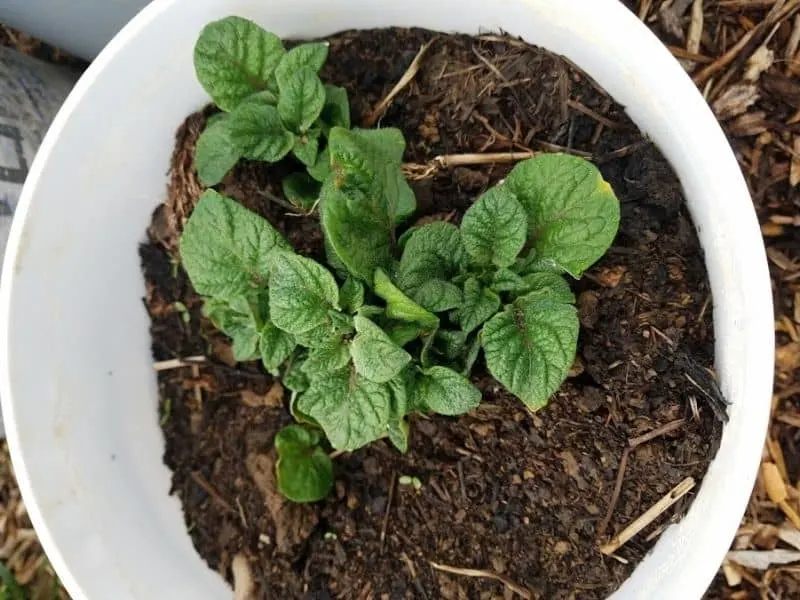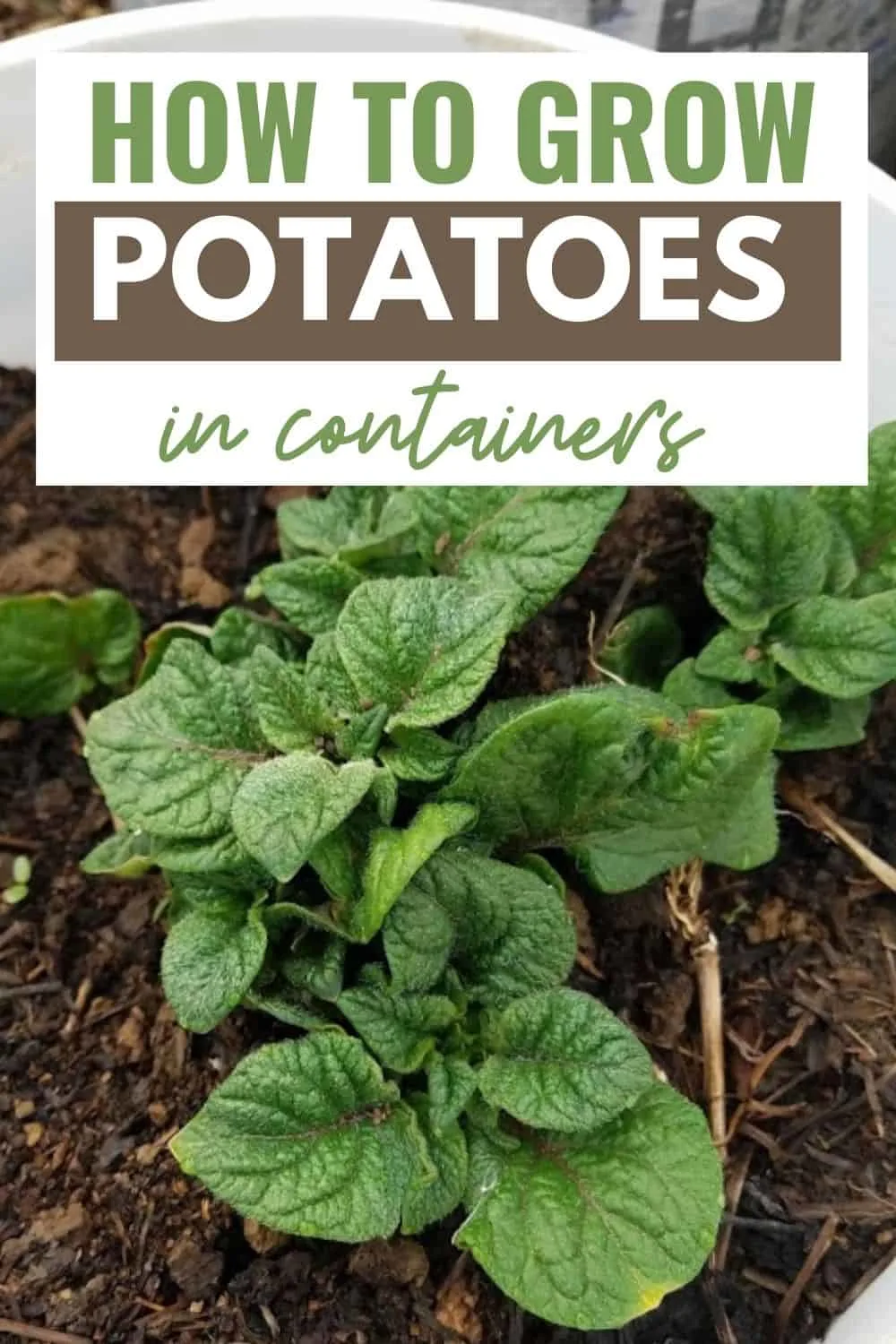Potatoes are a surprisingly easy and nutrient-rich addition to container gardens. Here’s how to grow potatoes in containers, so you can enjoy them even when you don’t have a lot of garden space.

These Peruvian vegetables provide healthy amounts of iron, potassium, vitamin B6, and vitamin C, according to the United States Potato Board, and the skin of one medium potato contains two grams of fiber.
How To Grow Potatoes in Containers
Aside from the nutritional benefits, a potato container garden has many advantages. Using fresh potting soil reduces the risk of soil-borne diseases and damage from harmful insect larvae, and the containers themselves protect the tubers from hungry rodents and other pests. And when harvest time comes, all you have to do is dump out the contents of the container: no digging necessary, and thus no worry of accidentally stabbing potatoes with a digging fork.
Choosing and preparing seed potatoes
Container potatoes won’t grow as large as those in a garden, so choose smaller varieties over russet or “baking” potatoes.
While early-season potatoes mature quickly and all at once, mid-and late-season types will continue to form tubers for a longer period of time, thus increasing your yield. Which of these types you choose really comes down to whether you want to harvest sooner or more.
Note that any type of potato can be harvested early and eaten as “new potatoes,” making mid-to-late-season types more versatile. We absolutely LOVE picking a bucket or two for new potato fries: YUM!
Some recommended potato varieties for container gardening include the following:
- Dark red Norland – medium-large, oblong early-season potato with red skin and firm, white flesh.
- Huckleberry gold – round to oval mid-season potato with purple skin and yellow flesh.
- Amarosa fingerling – oblong mid-season fingerling potato with burgundy skin and creamy, deep red flesh.
- Yukon gem – round to oval mid-season potato with yellow skin and buttery yellow flesh.
- Russian banana fingerling – crescent-shaped late-season fingerling potato with yellow skin and buttery, tender, yellow flesh.
Begin preparing seed potatoes one or two days before planting. While smaller seed potatoes can be planted whole, larger ones should be cut into one- to two-inch pieces. Make sure that each piece contains at least one eye, or dimpled area containing a bud.
Then let the pieces sit in a single layer for 24 to 48 hours to allow the cut surfaces to dry and form a protective layer against rotting.
To get a head start on growing, “chit,” or pre sprout, your seed potatoes a full six to eight weeks in advance. Place them in chitting trays, paper egg cartons, or cardboard trays in a cool, bright place where frost won’t reach.
When it comes time to plant, handle the potatoes carefully so as not to break off any of the tiny sprouts. Although chitting encourages earlier yields, it can also result in fewer, larger potatoes, so if you prefer a large crop of small potatoes, this may not be the best way to go.
A note on seed potatoes vs. store-bought potatoes
Although it may be tempting to plant those shriveled potatoes in the back of your pantry, there are a couple of reasons you shouldn’t.
- First, store-bought potatoes may contain plant viruses, whereas seed potatoes purchased from a reputable source will be certified virus-free.
- Second, many grocery store potatoes have been treated with chemical sprout inhibitors designed to prevent them from growing in your pantry, and therefore they won’t grow in soil, either.
Picking a container
Many different types of containers work well for growing potatoes, from store-bought “potato towers” or growing bags to food-grade five-gallon buckets.
Ideally, whatever container you choose should be:
- opaque
- two to three feet tall
- have a 10-15 gallon capacity.
An overly tall container will be difficult to water evenly, with the top portion drying out while the bottom portion remains soggy, inviting rot.
If you take a DIY approach with a barrel, garbage bin, plastic tub, or buckets, choose a container that has not held any toxic materials, give it a good scrub, and add a few drainage holes if there aren’t any.
How many containers do you need?
That depends on the size of the container and the desired quantity of potatoes. A good rule of thumb is three to five gallons of soil per potato plant, so a 15-gallon container will hold three to five plants.
Check the planting instructions for your seed potatoes, as well; some varieties have a tighter bunching habit and thus require a bit less space, whereas those that produce higher yields will need more soil.
Of course, if you have enough space in the garden, planting potatoes directly in the ground will produce better yields.
Preparing the potting soil
To encourage healthy growth and prevent rotting, use a quality, lightweight potting mix that retains moisture yet drains excess water. The simplest way to do this is to mix one part “soilless” potting mix with one part compost.
Alternatively, mix equal parts coconut coir, perlite, or vermiculite, and compost. Coconut coir will not only aid in moisture retention and proper drainage but also provide an ideal pH level of 5.2-6.3.
It is important to not use plain garden soil in a potato container garden, as it will compact easily and thus drain poorly, yet it will also dry out quickly. Garden soil can also contain weed seeds and diseases that would otherwise not be present in a container garden.
Positioning the seed potatoes and caring for the plants
Potatoes can be planted as early as two to three weeks before the last frost. First, put the containers where you want them; once they’re full of soil and growing potatoes, they will be difficult to move! The best location will receive at least six to eight hours of direct sunlight each day.
Instead of filling each container all the way to the top with potting mix, start with just six to eight inches in the bottom. Moisten the soil, then place the seed potatoes or pieces six to 12 inches apart and at least four inches from the edge of the container, with the eyes facing up. Just nestle them on top of the soil, then cover with an additional three to six inches of potting mix.
As the plants grow, gently add more potting mix every two weeks or so, leaving about six inches of each plant showing at any given time. This ensures the tubers remain covered at all times and also encourages larger yields.
Keep the soil moist but not damp throughout the growing period — whenever the top one to two inches of soil feels dry, give the plants just enough water for it to begin seeping out the drainage holes.
Causes and solutions to problems with potato plants
If you follow all of the tips above, you will likely encounter few problems with your potato container garden. However, sometimes pests and diseases are inevitable. The most likely pest is the Colorado potato beetle, a round, light-brown insect with black stripes. The larvae are reddish with two rows of black spots down each side. If you see these beetles or larvae, pick them off by hand and crush any egg masses. An overwhelming infestation can be treated with organic spinosad.
In addition, watch potato plants for the fungal diseases early and late blight, which appears as brown or black lesions on the leaves and stems and occasionally affects the tubers.
Sufficient airflow between plants and proper watering to avoid wetting the foliage will help prevent blight. If you do notice signs of blight on your potatoes, burn or dispose of the affected plants, harvesting any unblemished tubers to eat.
An organic fungicide like Actinovate can control the disease and prevent it from spreading.
Harvesting container potatoes
You can harvest new potatoes any time after the plants flower. To do this, dig gently into the top layer of soil and remove the topmost potatoes as needed, being careful to not damage the remaining tubers.
For mature potatoes, wait until the foliage begins to turn yellow, then stop watering until it dies back. Once the foliage has died, or right before the first frost, tip the container over and sift through the soil for the potatoes.
To reduce mess, lay out a tarp first, then simply bundle up the soil and plants when finished and dump them in the compost pile. Remember to never put diseased or pest-ridden plants in the compost!
Place the potatoes out of sunlight to cure for a few weeks, then gently brush off any remaining excess soil. Do not wash the potatoes until you are ready to use them, as getting them wet can promote rot. Store potatoes in a cool, dark place like a root cellar or basement.
Disadvantages of growing potatoes in containers
The main disadvantage to growing potatoes in containers is that the plants will often produce fewer, smaller potatoes than they would be grown directly in the ground, though this also depends on the size of the container and spacing of plants. More space equals more, larger potatoes.
Another downside is the cost, though this, too, can be improved. If convenience is more important than the price tag, go ahead and purchase your ideal potato container and top quality potting mix.
To reduce costs, though, consider what containers you might have on hand or be able to acquire cheaply, such as:
- (clean) old buckets
- barrels
- empty feed sacks
A compost bin offers a free source of nutrients, though you still may want to invest in some coconut coir. And at the end of the season, save a few potatoes to use as free seed for next year!
Perfect potted potatoes
Now that you’re good and hungry for some creamy potatoes and eager to dig your hands into the soil, it’s time to get planting. Choose containers that work for your space and potato varieties that inspire your taste buds, add some quality potting mix, and enjoy the harvest.




How To Grow Strawberries In Containers - Tips For Bountiful Berries
Tuesday 1st of December 2020
[…] how to grow potatoes in containers […]
How To Grow Potatoes - A Step By Step Guide
Wednesday 25th of November 2020
[…] Related: How to grow potatoes. […]